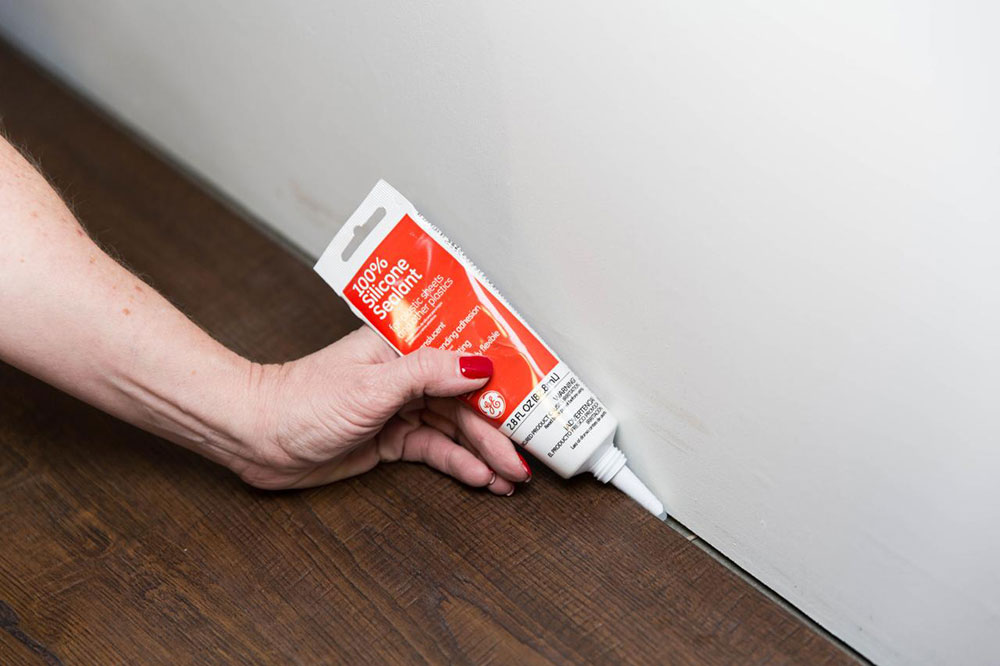Imagine stepping across your beautiful laminate flooring when, suddenly, you notice the first signs of wear along the seams—a common plight for many. Preserving the seamless charm of your laminate floors doesn’t have to be a battle against swelling and water damage.
Today, the focus is on a vital aspect of home maintenance—how to seal laminate flooring seams. This will ensure your flooring remains both stunning and durable.
By the end of this guide, you’ll have mastered the techniques to not only protect but also extend the life of your laminate flooring through effective sealing methods.
Prepare to dive into everything from choosing the right laminate joint sealer to the precise application method. This will include understandable steps covering waterproofing, gap filling, and other maintenance tips to boost your flooring’s resilience.
Equipped with these insights, seal your flooring like a pro—ensuring a finish that is as enduring as it is aesthetic.
How to seal laminate flooring seams
Here are the key steps to seal laminate flooring seams:
- Prepare the floor by removing furniture and cleaning the surface thoroughly with a mop and water.
- Apply a laminate flooring sealant along the seams between planks using a mop or rag. Spread it evenly, avoiding thick spots that will leave a milky film.
- Let the sealant dry completely before applying additional coats if needed. Check the manufacturer’s instructions for drying time and compatibility with multiple coats.
- Seal the expansion gaps around the perimeter of the room before installing baseboards. Use a flexible silicone sealant that allows the floor to expand and contract.
However, sealing the entire laminate floor is generally not recommended and may void the manufacturer’s warranty. Laminate flooring already has a protective plastic coating and is designed to resist moisture penetration.
The most important steps are properly installing the laminate with expansion gaps, locking the planks together tightly, and cleaning up spills promptly. Applying sealant to the seams is an extra precaution but not always necessary.
Sealing laminate flooring seams
Items required
First, you will need to get a few things before you start this project. You will need:
- Mop
- Water
- Floor buffer
- Protective clothing
- Floor sealant (you can choose whichever you want)
Be sure to read the laminate floor manufacturer’s information on how to seal laminate flooring seams. You have to check if a certain type of sealant is suitable for the flooring you have. In most cases, 100 percent silicone caulk is good with any brand, but not with the other sealers. So be careful and read the instructions to prevent unnecessary damage.
There are different sorts of sealants for different laminate floors. For example, you may search a specific color to match the laminate floor.
Preparing the floor
There are four main steps to seal the seams. Applying the sealant may seem easy, but there are still some instructions to follow.
The first step is to prepare the working area. Clean the room and take out everything you can. Clean space will make the job way easier. You will have easy access to all the parts of the room during the application. Also, you won’t risk damaging any of the other objects and furniture.
Next, you will do mopping and washing the floor. Be very detailed. Even the tiniest particles of dust can have an impact on sealant quality.
After you finish the cleaning, it is time to prepare yourself. Put on a working suit or some old clothes and get a pair of protective gloves. There are some chemicals in the sealant that may damage the clothes and even lead to bad skin reactions.
Preparing the solution
There are usually instructions on the label. They are often different for different brands, so it is crucial to check this out.
Prepare a couple of buckets. Sometimes it is needed to mix two solutions or to water down one solution. Choose bucket or container size dependent on the size of the room you’re working on. There are some sealants that don’t demand additional preparation and are ready to use immediately.
Let the floor dry before you start applying any sealant. It is a process, but it will pay off.
Applying the sealant

Try to imagine the floor surface as a canvas and smearing the solution as a painting. To apply the sealant, use a mop or a rag as a painting brush. Try to get an even amount of the solution over the entire surface. If you apply too much in a certain area, it will form a milky film. You should remove that and re-apply the sealing solution.
There are some types of sealants you can apply in multiple layers. Of course, you should wait for every coating to dry completely before applying another one. But don’t overdo it, because at some point it will damage and deform the looks of the floor.
The label of the sealant should also have information on how a certain brand reacts with a specific type of wood.
Drying
While reading instructions about how to seal laminate flooring seams, it might seem dull. Especially this part of the process can be a bit boring, be it is better to be patient. Wait for the solution to dry on its own completely and don’t use anything to speed it up. being impatient may cause damage and then you’ll have to start over. The exception is if the sealant’s label says you can. Wait even between every individual coating.
Use a clean rag or a floor buffer after the coating dries up. This will increase the shine of the laminate floor.
You may do this for each coat, but be aware it will take more time to finish the sealing. It is not necessary, except for the top layer.
Edges
Some people decide to cover the entire laminate floor with a coat of wax polish. For some types of laminate floors, this does work and go well. But, many manufacturers advise not to apply a sealant over the entire surface.
Most of the laminate floors have a thin plastic layer on the top, which is already resistant to moisture. This layer is the one with the wood grain pattern on it. For this reason, the sealing solution won’t have anything to bond with. The laminate floors won’t absorb it.
Some laminate floor types already have some layer of protection. If you install the laminate boards properly, moisture won’t be able to go through and damage them. Just make sure boards are correctly locked.
Using urethane or polyurethane sealants
Don’t skip applying the sealant along the floor edges against the wall. Use a small brush for this. Frame the entire perimeter of the room. Be careful to cover the full area that will later be hidden with the baseboard.
Be detailed especially around the doorjambs and around the cabinets. Pay extra attention to the doorjamb line connecting the rooms.
For example, if you’re working in a room connected to the bathroom. This also goes for areas around the plumbing fixtures, toilet bases, sink bases, bathtubs, shower enclosures… Or in the kitchen around the dishwasher. Basically, any areas water-related.
Using silicone caulk

The caulk silicone is easy to apply. It is sealed in tubes and to use it, just cut the tip of the tube to make a small opening.
Imagine it as glazing a cake. Squeeze the silicone out as you move slowly along the seams. Simply follow the line.
After applying it, smooth it out using a wet finger or a putty knife. This way you will also remove the excess silicone.
Water damage can be a nightmare. This is why it is good to seal your laminate with some kind of solution. And if you wondered how to seal laminate flooring seams, this article will surely help. Laminate is somewhat water-resistant, but it is not entirely waterproof. Moisture damage can be prevented with silicone, silicone caulk, urethane, or polyurethane sealants… It will cost less to take some protective measures than to fix the potential water damage.
FAQ On How To Seal Laminate Flooring Seams
What type of sealer is best for laminate flooring seams?
Silicone-based sealants are often recommended due to their flexibility and water resistance. They bond well with laminate and can effectively prevent moisture from seeping through the seams.
How often should I reseal my laminate flooring?
Typically, resealing is not frequently required unless the area experiences high moisture or heavy foot traffic. Checking the seams annually for signs of wear is prudent, however.
Can I seal the seams of laminate flooring myself?
Absolutely, DIY enthusiasts can successfully seal their laminate flooring seams using readily available sealants and following detailed application instructions. Ensure the floor is clean and dry before starting.
Will sealing the seams affect the appearance of my laminate flooring?
If done correctly, the sealant should be nearly invisible. Choose a sealant that dries clear and apply it carefully, smoothing out any excess to maintain the floor’s aesthetic.
What tools will I need to seal laminate flooring seams?
Gather a caulking gun, a tube of laminate sealant, a utility knife for opening the sealant tube, and a cloth to clean up any excess. These basics will assist in a smooth operation.
Is it necessary to remove existing sealer before reapplying new sealer?
Yes, if the old sealer is visibly damaged or peeling, removing it will ensure the new seal adheres correctly. Use a fine-grit sandpaper gently if required.
What should I do if the seam has already lifted or swollen?
Address any moisture source first. If swelling is minimal, sealing may suffice but significant lifting might require replacement of the affected planks before sealing.
Are there environmentally friendly sealant options for laminate flooring?
Yes, look for low-VOC (Volatile Organic Compounds) sealants which are less harmful to indoor air quality. These are environmentally friendlier and equally effective.
How long before I can walk on the floor after sealing the seams?
It generally takes about 24 hours for the sealant to cure fully. Avoid heavy foot traffic during this period to ensure the seal sets well.
What is the best way to maintain the sealed seams on laminate flooring?
Regular cleaning with a damp—not wet—mop and immediate cleanup of spills will enhance the longevity of your seal. Avoid harsh chemicals that might degrade the sealant.
Conclusion
Wrapping up, sealing seams in laminate flooring is not just about aesthetics; it’s a crucial step towards durability and longevity. The techniques covered today form a protective barrier against moisture—your floor’s invisible enemy. Whether choosing to use a laminate joint sealer or a versatile silicone-based solution, the key lies in meticulous application. Stepping through the process:
- Ensure surfaces are spotless,
- Apply the sealant with precision,
- And allow adequate curing time.
Following these steps will not only safeguard your floors but also maintain their pristine appearance. Remember, an ounce of prevention in maintenance can equate to a significant extension of your laminate’s life, keeping it splendid and structurally sound for years to come. Maintain regular checks on the seal integrity and address any concerns early to enjoy seamless beauty underfoot.

